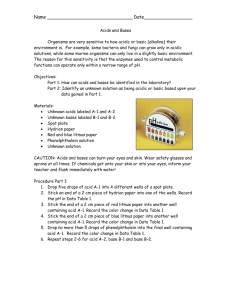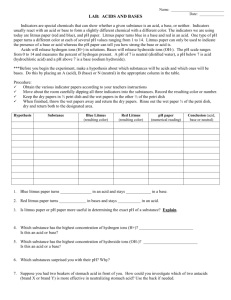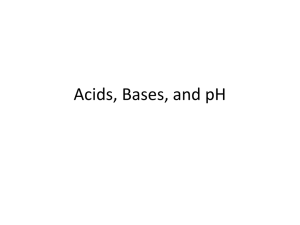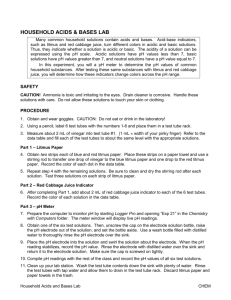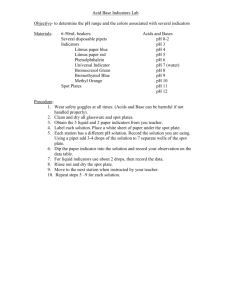Chapter 14 acid/base properties lab
advertisement
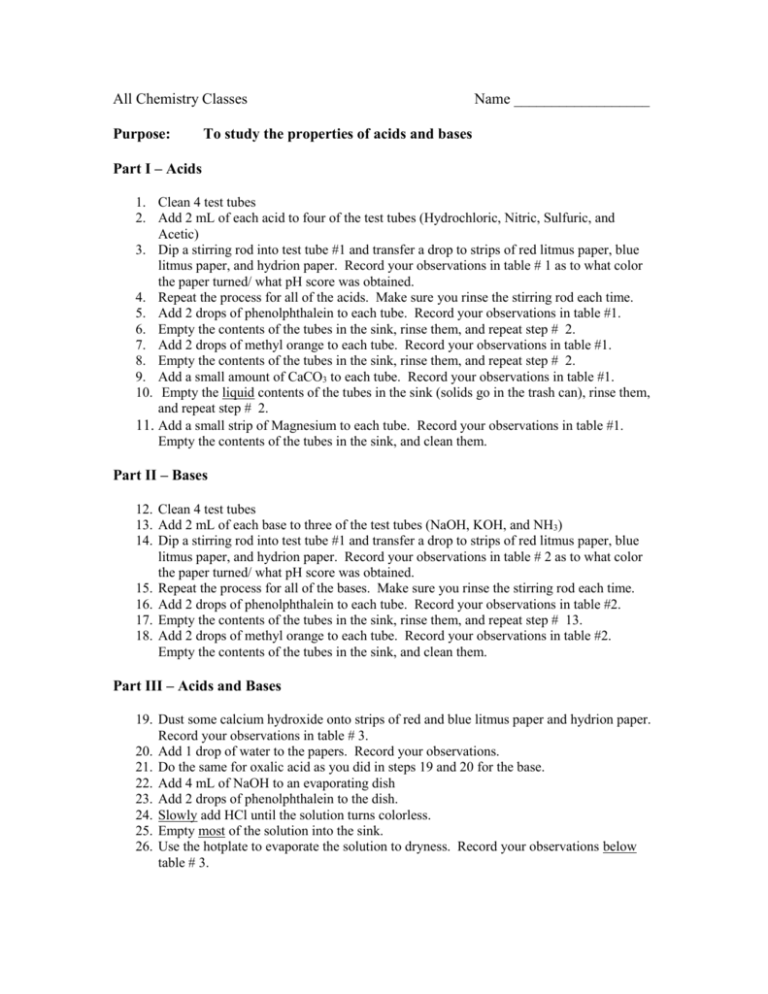
All Chemistry Classes Purpose: Name __________________ To study the properties of acids and bases Part I – Acids 1. Clean 4 test tubes 2. Add 2 mL of each acid to four of the test tubes (Hydrochloric, Nitric, Sulfuric, and Acetic) 3. Dip a stirring rod into test tube #1 and transfer a drop to strips of red litmus paper, blue litmus paper, and hydrion paper. Record your observations in table # 1 as to what color the paper turned/ what pH score was obtained. 4. Repeat the process for all of the acids. Make sure you rinse the stirring rod each time. 5. Add 2 drops of phenolphthalein to each tube. Record your observations in table #1. 6. Empty the contents of the tubes in the sink, rinse them, and repeat step # 2. 7. Add 2 drops of methyl orange to each tube. Record your observations in table #1. 8. Empty the contents of the tubes in the sink, rinse them, and repeat step # 2. 9. Add a small amount of CaCO3 to each tube. Record your observations in table #1. 10. Empty the liquid contents of the tubes in the sink (solids go in the trash can), rinse them, and repeat step # 2. 11. Add a small strip of Magnesium to each tube. Record your observations in table #1. Empty the contents of the tubes in the sink, and clean them. Part II – Bases 12. Clean 4 test tubes 13. Add 2 mL of each base to three of the test tubes (NaOH, KOH, and NH3) 14. Dip a stirring rod into test tube #1 and transfer a drop to strips of red litmus paper, blue litmus paper, and hydrion paper. Record your observations in table # 2 as to what color the paper turned/ what pH score was obtained. 15. Repeat the process for all of the bases. Make sure you rinse the stirring rod each time. 16. Add 2 drops of phenolphthalein to each tube. Record your observations in table #2. 17. Empty the contents of the tubes in the sink, rinse them, and repeat step # 13. 18. Add 2 drops of methyl orange to each tube. Record your observations in table #2. Empty the contents of the tubes in the sink, and clean them. Part III – Acids and Bases 19. Dust some calcium hydroxide onto strips of red and blue litmus paper and hydrion paper. Record your observations in table # 3. 20. Add 1 drop of water to the papers. Record your observations. 21. Do the same for oxalic acid as you did in steps 19 and 20 for the base. 22. Add 4 mL of NaOH to an evaporating dish 23. Add 2 drops of phenolphthalein to the dish. 24. Slowly add HCl until the solution turns colorless. 25. Empty most of the solution into the sink. 26. Use the hotplate to evaporate the solution to dryness. Record your observations below table # 3. Table # 1 HCl HNO3 H2SO4 NaOH KOH NH3 Red Litmus Blue Litmus Hydrion Paper Phenolphthalein Methyl Orange CaCO3 Mg Table # 2 Red Litmus Blue Litmus Hydrion Paper Phenolphthalein Methyl Orange Table # 3 Red Litmus Dry Ca(OH)2 Ca(OH)2 + H2O Dry oxalic acid Oxalic acid + H2O Blue Litmus Hydrion Paper HC2H3O2 Lab report requirements: 1. Complete the data tables in this lab with accurate and complete observations. 2. Fully answer the following questions. Questions 1. How do acids and bases affect litmus differently? 2. How do the liquid indicators in this lab detect/not detect acids and bases? 3. Explain the results that you observed when you placed the dry acids and bases on the indicator papers and how those results changed when water was added. 4. Complete and balance the following equations: HCl + CaCO3 H2SO4 + CaCO3 Mg + HC2H3O2 Mg + HNO3 5. Complete and balance the following equations using phase notation (symbols): HCl( HNO3( ) ) + Mg( ) + CaCO3( ) 6. Write a complete and balanced equation with phase notation (symbols)showing what happens when either oxalic acid or calcium hydroxide are mixed with water. 7. Write a complete and balanced equation with phase notation (symbols)showing what happened when you mixed hydrochloric acid and sodium hydroxide.
